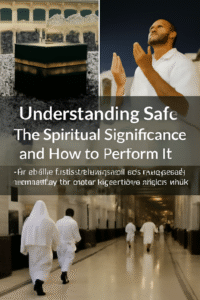Understanding Sa’i: The Spiritual Significance and How to Perform It
Introduction: What is Sa’i?
Sa’i is one of the key rituals of Umrah and Hajj, performed by walking seven times between the hills of Safa and Marwah. This ritual commemorates the actions of Siti Hajar, the wife of Prophet Ibrahim, who searched for water for her son, Prophet Ismail. The act of Sa’i symbolizes effort, perseverance, and trust in Allah’s mercy.
1. The Spiritual Significance of Sa’i
Sa’i is not just a physical act; it carries profound spiritual significance. The ritual teaches pilgrims about sacrifice, patience, and trust in Allah. Here’s why Sa’i holds such importance:
- Purification of Intentions (Niyyah): Performing Sa’i is an act of worship and must be done with the purest of intentions, seeking Allah’s pleasure and forgiveness.
- Symbol of Effort and Patience: Just as Siti Hajar walked tirelessly between Safa and Marwah in search of water for her son, Sa’i teaches pilgrims the value of persistent effort and patience in their journey towards Allah.
- Connecting with the Legacy of Prophets: By walking between Safa and Marwah, Muslims reconnect with the legacy of Prophet Ibrahim and Siti Hajar, whose story is a reminder of unwavering faith and trust in Allah’s provisions.
2. How to Perform Sa’i: Step-by-Step Guide
Performing Sa’i involves specific steps that must be followed correctly. Here’s a simple guide for pilgrims on how to perform Sa’i properly:
- Step 1: Entering the State of Ihram: Before beginning the Sa’i, you must enter the state of Ihram (a state of spiritual purity) and have the intention (niyyah) to perform Umrah or Hajj.
- Step 2: Begin from Safa: Stand on the hill of Safa, facing the Kaaba, and make du’a (supplication). The first time you look at the Kaaba, say “Allahu Akbar” (Allah is the Greatest).
- Step 3: Walk to Marwah: Begin walking toward Marwah. While walking, it is recommended to say dhikr (remembrance of Allah) or make personal du’a.
- Step 4: Complete the Seven Circuits: Repeat this process seven times, walking from Safa to Marwah and back. End at Marwah after the seventh lap.
- Step 5: Tawaf after Sa’i: After completing Sa’i, pilgrims are required to perform Tawaf (the act of walking around the Kaaba seven times) as part of the Umrah or Hajj rituals.
3. Common Mistakes to Avoid During Sa’i
While Sa’i is a relatively simple ritual, there are some common mistakes that pilgrims may make:
- Rushing the Process: Sa’i is not about completing the ritual quickly but about taking time to focus on your prayers and connection with Allah. It is important to walk at a comfortable pace and engage in meaningful supplication.
- Skipping Du’a: Many pilgrims forget to make du’a during Sa’i. It is a highly recommended act to ask Allah for forgiveness, blessings, and guidance during this journey.
- Not Being Mindful of Ihram Rules: While performing Sa’i, ensure you adhere to the rules of Ihram. Do not cut your hair or nails, and avoid wearing perfume or engaging in any intimate relations.
4. The Benefits of Sa’i: A Path to Spiritual Growth
Sa’i is more than just a physical act; it is a spiritual journey. Here are some of the benefits:
- Purification of the Soul: Sa’i allows you to cleanse your soul and draw closer to Allah. It is an opportunity to leave behind worldly distractions and focus solely on worship.
- Increased Patience and Gratitude: The act of walking between Safa and Marwah teaches patience and reliance on Allah. It is a reminder that spiritual rewards often require effort and perseverance.
- Strengthening Your Connection with Allah: Sa’i is a moment to ask Allah for forgiveness, strength, and blessings, and to reflect on the significance of your journey.
5. Conclusion: Sa’i as an Integral Part of Your Pilgrimage
Sa’i is a crucial part of the Umrah and Hajj rituals. It represents more than just walking between two hills; it is a powerful reminder of faith, patience, and trust in Allah. By following the proper steps and understanding the spiritual significance of Sa’i, you can enhance your pilgrimage experience and deepen your connection with Allah.
Call to Action: Want to learn more about the rituals of Umrah and Hajj? Click here for more tips and guides to prepare for your spiritual journey.

